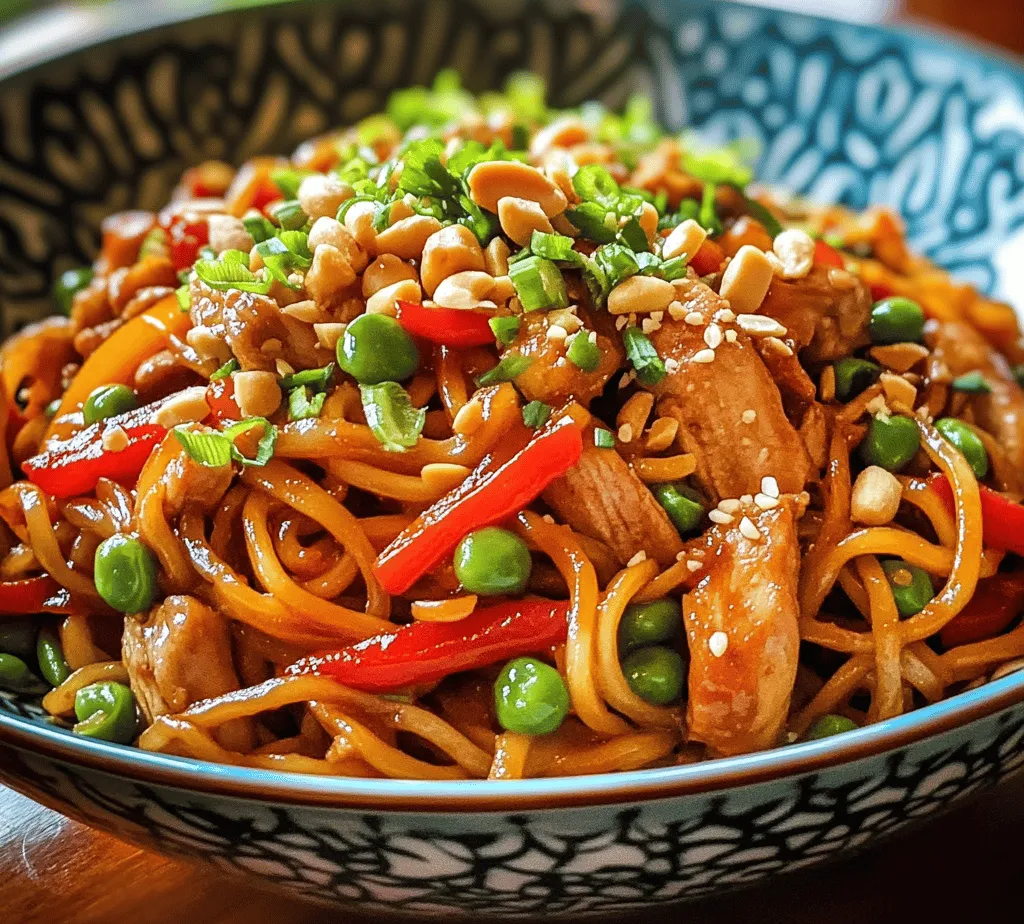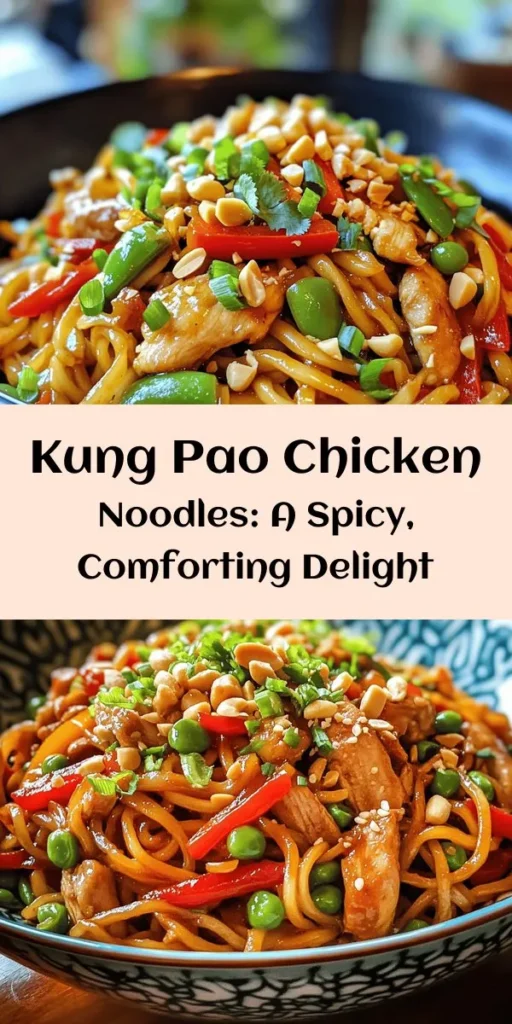Introduction
Kung Pao Chicken Noodles is a delightful fusion of two beloved culinary staples, merging the spicy, savory flavors of the classic Kung Pao Chicken with the comforting texture of egg noodles. This dish brings a taste of Asia right to your kitchen, inviting you to explore the rich culinary traditions that have made it a favorite across the globe. With its vibrant colors and a symphony of flavors, Kung Pao Chicken Noodles not only satisfies your taste buds but also offers a nourishing meal loaded with healthy ingredients.
As you prepare to embark on this cooking adventure, it’s essential to recognize the significance of Kung Pao Chicken within Asian cuisine. This iconic dish is celebrated not just for its bold flavors but also for its intricate balance of textures—tender chicken, crunchy vegetables, and nutty peanuts come together to create a truly satisfying experience. Moreover, the nutritional benefits of the ingredients used in this recipe make it an excellent choice for a wholesome meal that caters to both flavor and health.
Understanding Kung Pao Chicken
Kung Pao Chicken is steeped in history, tracing its origins back to the late Qing Dynasty in China. Named after Ding Baozhen, a governor of Sichuan Province, who was known as Kung Pao, this dish reflects the region’s love for bold and complex flavors. Traditionally, Kung Pao Chicken is prepared with diced chicken stir-fried with peanuts, vegetables, and a tantalizing sauce made from a mix of soy sauce, vinegar, and chili peppers. The dish has evolved over the years, adapting to various tastes and preferences, which has led to numerous regional variations across China and beyond.
The role of Kung Pao Chicken in Chinese culinary culture cannot be overstated. It embodies the principles of balance and harmony—qualities that are central to Chinese cooking. Each ingredient contributes to the overall flavor, with the heat of the Sichuan peppercorns perfectly complementing the sweetness of the hoisin sauce and the umami of the soy sauce. This dish is not just a meal; it is an experience that showcases the artistry of Chinese cuisine.
Ingredients Overview
To create the perfect Kung Pao Chicken Noodles, it’s crucial to understand the key ingredients that contribute to this dish’s distinct taste and texture.
Egg Noodles
Egg noodles are the foundation of this recipe, providing a soft, chewy texture that absorbs the flavors of the sauce beautifully. Various types of egg noodles can be used, including fresh, dried, or even homemade versions. Each type offers its own unique texture, but fresh egg noodles are often preferred for their tenderness. They are typically made from wheat flour and eggs, which adds richness to the dish. Additionally, egg noodles are a good source of carbohydrates, making them a satisfying base for the protein and vegetables.
Chicken Thighs
When it comes to the protein component of Kung Pao Chicken Noodles, chicken thighs are the preferred choice. Unlike chicken breasts, thighs are juicier and more flavorful, making them ideal for stir-frying. Their higher fat content ensures that they remain tender and moist during cooking, allowing them to absorb the marinade and sauce more effectively. Plus, chicken thighs are a great source of protein and essential nutrients, making this dish both delicious and nutritious.
Sauces
The sauces used in Kung Pao Chicken Noodles are what truly elevate the dish.
– Soy Sauce: This staple ingredient adds depth and umami, contributing to the overall savory profile of the dish. It also provides a beautiful color to the sauce.
– Rice Vinegar: This ingredient introduces a subtle acidity that balances the richness of the soy sauce and chicken, enhancing the dish’s overall flavor.
– Hoisin Sauce: Known for its sweet and tangy taste, hoisin sauce adds a layer of complexity and richness, complementing the spiciness of the dish.
Vegetables
Fresh vegetables play a vital role in adding color, crunch, and nutrition to Kung Pao Chicken Noodles. Common choices include bell peppers, zucchini, and green onions, each offering their own unique taste and texture. These vegetables are rich in vitamins and minerals, providing health benefits that enhance the overall nutritional value of the dish. The combination of cooked and raw vegetables also adds visual appeal, making the meal more inviting.
Peanuts and Sichuan Peppercorns
Peanuts are essential in Kung Pao Chicken, providing a crunchy texture that contrasts beautifully with the tender chicken and vegetables. They also contribute healthy fats and protein, making the dish more filling. Sichuan peppercorns, on the other hand, bring a distinctive numbing heat that is characteristic of Sichuan cuisine. Their unique flavor profile enhances the dish, making each bite a delightful surprise.
Importance of Fresh Ingredients
Using fresh, high-quality ingredients is crucial for achieving an authentic taste in Kung Pao Chicken Noodles. Fresh vegetables provide vibrant colors and essential nutrients while enhancing the dish’s overall flavor. Similarly, using fresh chicken ensures that the meat remains tender and juicy. When you prioritize fresh ingredients, you not only improve the quality of your meal but also support local farmers and sustainable practices.
Preparation Steps Explained
Now that we’ve covered the essential ingredients, let’s dive into the preparation steps that will help you create a mouthwatering dish of Kung Pao Chicken Noodles.
Marinating the Chicken
The first step in preparing Kung Pao Chicken Noodles is marinating the chicken. Marinating is vital for infusing the meat with flavor and ensuring tenderness. The marinade typically consists of soy sauce, rice vinegar, a touch of sesame oil, and cornstarch.
– Soy Sauce: Imparts salty, umami flavors to the chicken.
– Rice Vinegar: Adds acidity to tenderize the meat and enhance flavor.
– Sesame Oil: Contributes a rich, nutty aroma that complements the other flavors.
– Cornstarch: Creates a protective coating that helps keep the chicken moist during cooking.
Combine these ingredients in a bowl, add the diced chicken thighs, and let them marinate for at least 30 minutes, allowing the flavors to penetrate the meat fully. For best results, marinate the chicken in the refrigerator to prevent any bacterial growth.
Cooking the Noodles
While the chicken is marinating, you can prepare the egg noodles. Start by bringing a pot of salted water to a boil and add the noodles. Cook them according to the package instructions, typically around 3-5 minutes for fresh noodles. You want them to be slightly undercooked, as they will finish cooking in the stir-fry with the other ingredients.
Once the noodles are cooked, drain them and rinse them under cold water to stop the cooking process and prevent them from sticking. Set them aside while you move on to stir-frying the chicken and vegetables, as this will ensure that they are ready to be incorporated into your dish just at the right moment.
By following these initial steps, you have laid the groundwork for a delicious and satisfying meal. The combination of marinated chicken and perfectly cooked noodles sets the stage for a delightful culinary experience that captures the essence of Kung Pao Chicken Noodles. Stay tuned for the next part, where we will explore the stir-frying process and the assembly of this mouthwatering dish!

Tips for Achieving the Perfect Al Dente Texture
When cooking noodles for your Kung Pao Chicken Noodles, achieving the perfect al dente texture is crucial. Al dente, which means “to the tooth” in Italian, refers to pasta that is cooked until firm, not soft. Here are some tips to help you master this technique:
1. Use Plenty of Water: When boiling noodles, always use a large pot with ample water. This helps maintain the temperature of the water when the noodles are added, allowing them to cook evenly.
2. Salting the Water: Just like cooking pasta, adding salt to the boiling water enhances the flavor of the noodles. A good rule of thumb is to add about 1-2 tablespoons of salt for every 4 quarts of water.
3. Check the Cooking Time: Follow the package instructions for cooking time, but start checking for doneness a minute or two before the recommended time. Taste a noodle to see if it has the desired firmness.
4. Rinse with Cold Water: Once the noodles are cooked to al dente perfection, drain them and quickly rinse under cold water. This stops the cooking process and helps maintain their firm texture until you are ready to stir-fry them.
How to Prevent Noodles from Sticking
Sticking noodles can ruin the texture of your dish. Here’s how to prevent that:
1. Toss with Oil: After rinsing the noodles, toss them with a small amount of oil (such as sesame oil or vegetable oil). This forms a barrier and keeps the noodles separate.
2. Use a Non-Stick Pot: If possible, cook your noodles in a non-stick pot to further minimize sticking.
3. Stir Frequently: While the noodles are boiling, make sure to stir them frequently. This helps prevent them from clumping together.
Stir-Frying Techniques
Stir-frying is a quick cooking method that relies on high heat and constant movement. Here are essential techniques to get it right:
Importance of High Heat and Quick Cooking
1. Preheat Your Wok or Pan: Before adding any ingredients, make sure your wok or frying pan is preheated. High heat is essential for achieving that crispy texture and locking in flavors.
2. Cook in Batches: If you’re making a large portion, cook the chicken or vegetables in batches. Overcrowding the pan can lower the temperature and lead to steaming rather than frying.
Tips for Achieving the Ideal Stir-Fry Texture
1. Cut Ingredients Uniformly: For even cooking, make sure your chicken and vegetables are cut into uniform sizes. This ensures that everything cooks at the same rate.
2. Use a Combination of Oils: Consider using a mix of oils, like peanut oil for high heat and sesame oil for flavor, to elevate the stir-fry experience.
Sautéing Vegetables
Sautéing is an integral part of the Kung Pao Chicken Noodles recipe. Proper timing and order can maximize the flavors of the dish.
Timing and Order of Adding Vegetables for Optimum Flavor
1. Start with Hard Vegetables: Always begin with the hardest vegetables first, such as bell peppers and carrots, as they take longer to cook. Sauté them for a couple of minutes before adding softer vegetables like zucchini or bok choy.
2. Finish with Delicate Greens: Add leafy greens or herbs towards the end of the cooking process. They require less time and will wilt beautifully without losing their vibrant color.
The Significance of Garlic and Ginger in Asian Cooking
Garlic and ginger are staples in Asian cuisine, particularly in stir-fries. They add depth and complexity to the dish.
1. Add Early for Infusion: Sauté garlic and ginger at the beginning of the cooking process to infuse the oil with their flavors.
2. Be Mindful of Timing: Be cautious not to burn them; they can turn bitter quickly. Add garlic and ginger just before the other ingredients to avoid overcooking.
Combining Ingredients
Integrating all the components in a stir-fry is an art. Here’s how to do it without compromising texture or flavor:
1. Layering Flavors: Add the chicken back to the pan after cooking the vegetables. This allows the chicken to absorb the flavors of the vegetables and sauce.
2. Adjusting Seasoning for Personal Preference: Taste your dish before serving and adjust the seasoning as needed. You may want to add more soy sauce, vinegar, or even a pinch of sugar to balance the flavors.
Nutritional Analysis
Understanding the nutritional content of your Kung Pao Chicken Noodles can help you make informed dietary choices. Here’s a breakdown:
– Calories: Approximately 400-500 calories per serving, depending on portion size and the amount of oil used.
– Proteins: Each serving provides around 30 grams of protein, thanks to the chicken.
– Fats: Expect about 15-20 grams of fat, primarily from the cooking oil.
– Carbohydrates: Noodles contribute approximately 50-60 grams of carbs.
Health Benefits of Each Ingredient
– Chicken: A great source of lean protein, essential for muscle repair and overall health.
– Noodles: Provide energy and are often fortified with vitamins and minerals.
– Vegetables: Packed with vitamins, minerals, and fiber, contributing to overall health and digestion.
– Peanuts: Offer healthy fats, protein, and a variety of nutrients.
Dietary Considerations
– Gluten-Free Options: For a gluten-free version, swap traditional noodles with rice noodles or gluten-free alternatives.
– Vegetarian Variations: Replace chicken with tofu or tempeh for a delicious vegetarian option without sacrificing flavor.
Serving Suggestions
Presentation can elevate your Kung Pao Chicken Noodles from a simple dish to a culinary masterpiece. Here are some ideas:
1. Plate Artfully: Serve the noodles in a large bowl or on a plate, garnished with chopped scallions, crushed peanuts, and a sprinkle of sesame seeds for an eye-catching presentation.
2. Pair with Side Dishes: This dish pairs wonderfully with steamed jasmine rice, spring rolls, or a light cucumber salad to balance the meal.
3. Beverage Pairings: For drinks, consider serving with a refreshing iced tea or a light beer that complements the dish’s flavors.
Cultural Significance of Sharing Meals in Asian Cuisine
In many Asian cultures, sharing meals is a cherished tradition. Kung Pao Chicken Noodles, with their vibrant flavors and communal nature, embody this spirit. Preparing this dish for family and friends encourages connection and conversation, turning a meal into an experience.
Conclusion
Kung Pao Chicken Noodles are not just a delicious dish; they represent a harmonious blend of flavors, textures, and cultural significance. With straightforward preparation and the ability to customize the ingredients, this recipe is perfect for both novice cooks and seasoned chefs.
By experimenting with flavors and incorporating your personal touch, you can elevate this dish to new heights. Whether you’re cooking for yourself or sharing with loved ones, the joy of preparing and enjoying Kung Pao Chicken Noodles will surely create lasting memories in the kitchen.
So gather your ingredients, embrace the vibrant colors of the vegetables, and enjoy the process of creating a dish that celebrates the art of cooking and the joy of sharing meals with family and friends.



